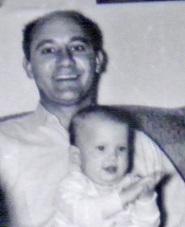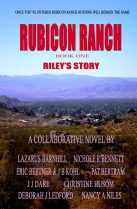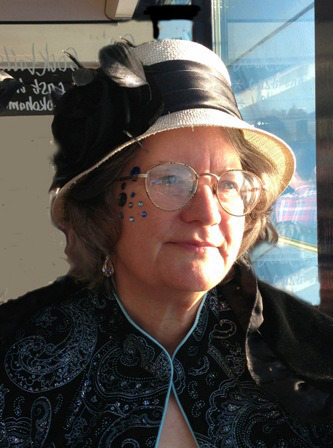Pat Bertram's Blog, page 238
April 8, 2013
Rubicon Ranch: Secrets — The Story Begins!
 Rubicon Ranch is a collaborative and innovative crime series set in the fictional desert community of Rubicon Ranch and is being written online by the authors of Second Wind Publishing. The very first chapter of the very first book (Rubicon Ranch: Riley’s Story) was posted on October 24, 2010, and we are still going strong! In fact, we are getting better and better. Seven authors, including me, are involved in the current story — Rubicon Ranch: Secrets, which is shaping up to be a psychological thriller.
Rubicon Ranch is a collaborative and innovative crime series set in the fictional desert community of Rubicon Ranch and is being written online by the authors of Second Wind Publishing. The very first chapter of the very first book (Rubicon Ranch: Riley’s Story) was posted on October 24, 2010, and we are still going strong! In fact, we are getting better and better. Seven authors, including me, are involved in the current story — Rubicon Ranch: Secrets, which is shaping up to be a psychological thriller.
The body of a local realtor is found beneath the wheels of a blow-up figure of a Santa on a motorcycle. The realtor took great delight in ferreting out secrets, and everyone in this upscale housing development is hiding something. Could she have discovered a secret someone would kill to protect? There will be suspects galore, including a psychic, a con man, a woman trying to set up an online call-girl service, and the philandering sheriff himself. Not only is the victim someone he had an affair with, but he will also have to contend with an ex-wife who has moved back in with him and a jilted lover, both with their own reasons for wanting the realtor dead.
Although some of the characters were introduced in Rubicon Ranch: Riley’s Story, the first collaboration in the series, and further developed in Rubicon Ranch: Necropieces, Rubicon Ranch: Secrets is a stand-alone novel, so don’t worry if you are new to Rubicon Ranch. A new chapter will be posted every Monday on the Rubicon Ranch blog. I’m posting the first chapter here, but if you don’t want to miss further chapters, please go to the blog and click on “sign me up” on the right sidebar to get notifications of new chapters.
We hope you will enjoy seeing the story develop as we write it. Let the mystery begin! Whodunit? No one knows, not even the writers, and we won’t know until the very end!
(If the Christmas theme seems unseasonal, well . . . considering how long it takes to write a book at the rate of a chapter a week, in a few months, the season will catch up to us!)
Chapter 1: Melanie Gray
by Pat Bertram
Sunday, December 22; 7:05pm
Melanie Gray typed THE END, then sat back and studied the words on the computer screen. She’d found no satisfaction in telling the story of famed horror writer Morris Sinclair’s macabre life and death, and she felt no elation now that she’d finished the task. The evil man should have been buried in unhallowed ground and left to rot rather than be immortalized in a book, but she’d needed the money her publisher had offered. With the generous advance, she would be able to devote herself to finding out who killed her husband five months previously and, more importantly, why the murderer wanted Alexander dead. Morris had wooed death his whole life, so it was no surprise that death had come for him, but Alexander’s murder could not be so easily dismissed.
Tears stung Melanie’s eyes. She scrubbed the tears away, furious at herself for still grieving. She’d always considered herself a strong woman, up to any task, and yet she couldn’t write “the end” to her grief.
Damn you, Alexander! How could you do this to me?
She rose stiffly, stretched to get the worst of the kinks from her body, and tottered to the front closet for her coat. Except for a few hours of fitful sleep each night during the past nine weeks, she’d spent all her time at the computer, and she was sick of it. Sick of Morris Sinclair. Sick of death. Sick of Rubicon Ranch.
She opened the front door and blinked at the shadowy figures gliding through the darkness. Morris’s fans had descended on the neighborhood when news of his demise had hit the airwaves, and they had stayed when they learned that not all of Morris’s body pieces had been recovered. Dressed as vampires and zombies and ghouls of every imaginable—and unimaginable—ilk, they roamed the neighborhood and the nearby desert looking for necropieces in some sort of grisly treasure hunt.
Melanie hesitated, wondering at the wisdom of going out so late in the evening, but the twinkle of Christmas lights adorning a nearby desert willow made her set aside her caution.
Alexander had always loved Christmas, and no matter where in the world they happened to be living, he managed to find a tree and decorate it. If Alexander still lived in her memory, he’d want her to wander through the neighborhood so he could see the lights.
Smiling at the whimsical thought, she locked the door behind her and strolled down the driveway to Delano Road. Even with half the houses lit up with holiday decorations, the neighborhood seemed dark. Too many people had left the area, temporarily abandoning their homes, though the flickering of candlelight through closed curtains hinted that squatters had taken up residence in some of the empty houses.
Melanie stood at the curb, trying to decide whether to go right or left. “It’s your fault, Alexander,” she murmured. “Until you died, I never had a problem making decisions.” But now, it didn’t make any difference whether she went north or south, whether she left Rubicon Ranch or stayed. Without Alexander, everything seemed uniformly bleak.
A house across the street all at once came ablaze with thousands of small white lights. Melanie cut across the road and headed for the brightness, wishing Alexander could see the decorations for real. Lights outlined the driveway, every bush, every rock, and dripped from the eaves like dazzling falls of lace.
She walked leisurely, savoring the radiant display on Alexander’s behalf, then hurried past the next dwelling, which was dark, and slowed again at the following house to look at the whimsical blow-up figure of Santa on a motorcycle.
After the brilliance of the lights at the first domicile, she had to wait a moment to let her eyes adjust to the relative dimness of this scene. And then she wished she hadn’t hung around to get a better look. Santa, with a wide grin and an upraised hand, seemed to be gleefully running over the prone body of a woman. A mannequin, it looked like.
Melanie drew in a sharp breath. Who would create such a morbid tableau for Christmas? But then, seeing a vampire with glowing teeth run past her, she sighed. Anyone in this insane neighborhood could have done it. After Morris Sinclair’s demise, Rubicon Ranch had become a bacchanalia of death, a celebration of the worst in humanity.
A car moved along the street behind her. The headlights illuminated the scene as clearly as if it were day, and suddenly something seemed wrong. So very wrong.
The woman being run over by the cheery Santa looked stiff in the way of death, not stiff like a mannequin.
Melanie told herself to continue on, to forget the gruesome sight and enjoy the rest of the decorations, but her leaden feet refused to do her bidding. Finally, wishing she were anywhere but here, she crept closer to the scene.
She caught a faint whiff of death—like meat just beginning to go bad—and her heart beat faster.
No. No. She’d had enough of death. Alexander. Poor kidnapped little Riley Peterson. Morris Sinclair. How could so much death be associated with a community as small as Rubicon Ranch?
Melanie bent over the body and touched a finger to the side of the woman’s neck to check for a pulse, though she already knew the truth.
She fumbled in her coat pocket for her cell phone and wondered if the sheriff would continue to believe in her innocence. Hell, she didn’t believe it herself. Maybe she was some sort of Typhoid Mary when it came to death. She’d been the one who found Riley Peterson’s body out in the desert, stuffed in a television console. She’d been the one to lead the sheriff to the desert where they’d found the body of Riley’s birth father. She’d been the first one to come across a necropiece—a dismembered foot—after Morris was killed. And now once again she had found death.
She punched in 999, but when the call didn’t connect, she realized she’d used the emergency number for Britain. She cleared the number, then punched 119. Crap. Wrong again. That was the emergency number for Mozambique. Where was she? She took a deep breath, and let it out slowly.
Rubicon Ranch. Rojo Duro County. Mojave Desert. California. USA. Ah, yes. 911.
Melanie made the call, gave the information to the dispatcher, then pulled her coat more firmly around her to protect her from the chill of the high desert winter night.
She’d expected to wait a half an hour or more until the sheriff or his deputies could make the thirty-mile trip from Rojo Duro, but only ten minutes had gone by when a dark SUV pulled up to the curb, and Deputy Kelvin Midget slid out from behind the wheel more nimbly than seemed possible for such a massive man.
The SUV didn’t have official county plates, so Melanie supposed the vehicle was the deputy’s private ride. She felt a spasm of guilt at cutting into the man’s personal time, but then she remembered what Deputy Midget had once told her—that he’d lost his wife to pancreatic cancer about three year and a half years ago, and had come out west to start over so he could heal. Maybe, like Melanie, he had no real life but was just going through the motions of living.
“What seems to be the trouble, Ms. Gray?”
Shivering, Melanie pointed to the body.
Midget picked his way through the xeriscaping, got down on his haunches to check the woman’s neck as Melanie had, then rose to his feet without using his hands to shove himself upright.
“Did you see what happened?”
“No. Just found her lying here is all. Checked her pulse. Called it in.”
Midget walked around to the other side of the body, scanning the ground, his dark brow furrowed. “Did you find her purse?”
“No, but I didn’t look for it.” Melanie wondered about the deputy’s concern for the woman. It seemed more than simply a law enforcement officer’s professional interest in a crime scene. “Did you know her?” she asked.
“Didn’t you?”
“I don’t think so. I don’t know many people in the neighborhood.”
“Seth—Sheriff Bryan—thinks you notice everything.”
“Well, the sheriff thinks a lot of things that aren’t true.”
Midget made a small sound that might have been a chuckle. “Hit a nerve, did I?”
More to get away from the uncomfortable topic of the Sheriff than because she wanted to identify the woman, Melanie circled the body so she could get a better look. The woman did appear familiar at that. Aquiline nose, close set eyes, coiffed hair, manicured fingernails with a shimmering design painted atop the polish, high heels, tailored business suit.
Melanie backed away from the body. “I think she might be a real estate agent. I’ve seen her around the neighborhood.”
“Nancy Garcetti,” Deputy Midget said. “She sold me my house. Poor woman. She was such a terrible judge of character. Looked at the superficial and assumed she knew what the person was about. Kept notes of everything. You sure you didn’t find her purse?”
“Maybe the person who murdered her took it.”
“What makes you think she was murdered?”
“What else could it be? Nancy got tired, so she decided to take a nap by the wheels of Santa’s motorcycle and froze to death?” Regretting her caustic tone, Melanie huddled deeper into her coat. Had she become so used to murder that all death seemed so unnatural? But death was unnatural. A deletion of life. A void.
“People die from many causes,” Deputy Midget said. “It’s possible she had a heart attack. A stroke. Some sort of accident. A mugging gone wrong. Could be anything. We won’t know until the ME gets here.”
A tan Navigator parked behind Midget’s SUV, and Lieutenant Rosaria Frio stepped out of the vehicle.
The lieutenant looked even more like an Hispanic Barbie doll than when Melanie first met her. No emotion showed on the law enforcement officer’s beautiful face, and the dim light made her skin look plastically perfect. Only the glitter of the lieutenant’s dark eyes and her easy stride confirmed her humanity.
She greeted Deputy Midget with a nod. “You got here fast.”
“I just bought a house here in Rubicon Ranch over on Adobe Pobre Court. I told you about it. Got an awesome deal from a couple who could hardly wait to get away from the area. They said there was too much crime.”
“Imagine that.” Lieutenant Frio turned to stare at Melanie. “And here is our one-woman crime spree herself. Or maybe cadaver dog would be a better description.”
Melanie returned the Lieutenant’s gaze, but refrained from answering in kind. Lieutenant Frio seemed to have taken her in dislike when they met after Riley’s murder and her manner had only grown colder with the passage of the months. Melanie didn’t entirely blame her. If their places were reversed, she’d probably be just as skeptical as the lieutenant about her penchant for finding corpses.
Lieutenant Frio walked to body and stood over it for a moment, then slanted a glance toward Melanie. “Sheriff Bryan will be here shortly. He and his wife were dining out, and he needs to take her home first.”
Melanie remained impassive. She already knew the sheriff and his wife were back together. Melanie had talked to him a couple of times to get details for her book, and he had told her his wife had decided the celebrity-ridden area might not be such a backwater after all. He’d sounded apologetic, but other than behavior that bordered on unprofessionalism, he had nothing to apologize for. They hadn’t had an affair, not even a fling. Just a little bit of flirtation and a lot of anger.
“Can I go?” she asked.
“I’ve questioned Ms. Gray,” Deputy Midget said. “If we need her again, we know where to find her.”
Lieutenant Frio turned her implacable gaze toward Melanie. “Don’t leave the county.”
If anyone else had deadpanned such a remark, Melanie would have assumed it was either a friendly suggestion or possibly a joke, but coming from the lieutenant, the command sounded like a jail cell slamming shut.
Melanie wanted to run back to her place, but she forced herself to walk since she was sure the lieutenant would see haste as a sign of guilt. She tried not to look at the houses she passed. The joyful decorations suddenly seemed obscene.
She didn’t believe Deputy Midget’s suggestion that Nancy had died of natural causes. The missing purse hinted that something grimmer was going on. What secrets Nancy had kept in her purse? Everyone in Rubicon Ranch seemed to have something to hide. And someone—perhaps someone in one of these very houses—might have a secret they would kill to protect.
***
Pat Bertram is the author of the suspense novels Light Bringer, More Deaths Than One, A Spark of Heavenly Fire, and Daughter Am I. Bertram is also the author of Grief: The Great Yearning, “an exquisite book, wrenching to read, and at the same time full of profound truths.” All Bertram’s books are published by Second Wind Publishing. Connect with Pat on Google+
Tagged: mystery series collaboration, online novel, Rubicon Ranch, Rubicon Ranch Necropieces, Rubicon Ranch: Secrets, Second Wind Publishing


April 7, 2013
Fight Scenes and Motivations by David Lucas
The internet truly is an egalitarian place. Where else would I be able to meet someone like David Alan Lucas, a writer, poet and martial artist who is an expert in the arts of physical and psychological combat?
David belongs to my Suspense/Thriller Writers’ group on Facebook, and he has been discussing fight techniques with the group. I asked if I could post part of his discourse, and he kindly said yes. Thank, you, David!
Fight Scenes and Motivations by David Lucas
This might be a bit of a ramble, but let’s talk about fight scenes. We all have our areas of expertise. Do you ever feel thrown out of a story or movie when “they” get it wrong? I know I do. I have closed those books and never picked it up again. If I go to a movie by myself, I will walk out of it. When I am with others, they can usually tell from my facial expression that I am biting my tongue. (I’m polite and don’t ruin it for them—there is always the after movie drive to talk about it.)
Besides being a writer, I am a fighter. I am a 3rd degree Black Belt in a Black Art (Black=War Art instead of a sport style). I have been in more hand to hand (or bare hand vs armed) fights than I even want to contemplate. Fight scenes are hard to write, even for me. But when someone gets it wrong I shake my head. But when they get it right, I want to jump up and dance (I almost did that when the 2009 Sherlock Holmes came out and they actually got into the Holmes’ head as he planned the fight before it began).
As a result of being a fighter and a writer, I have been writing about fight scenes and have given a few seminars. While I would imagine there is a book on how to write a fight scene, I haven’t seen it. So, I am going to tear apart the process as best as I can over the several months. Before I begin to outline it, let me be very clear: Writing is an art. Martial Arts is an art. There is no one way to do anything. Take from this what works for you, knowing that, like all writers and marital artists, we all walk our own path.
The first thing I do with writing a fight scene is to understand who is involved. When people fight in real life, everyone has a set of skills, a way they think, and a motive to be in the fight. Let’s work this backwards and start with motive. Why does your character want to fight?
Let’s face a few facts about fights. On film they can look exciting. But the truth is that in every fight (even among friends) there is a risk—even if it by accident—that you can lose your life. Let me use a real life example.
 Have you ever been there when someone yells, “Fight! Fight! Fight!” People gather around cheering it on. They are stupid. No I am not holding back punches. Here is the true story that happened in one such case and why I called them stupid. One of the fighters in such a case—it was at a bar—took a glass bottle and broke it. He swung wildly at his opponent. His wild swings cut the throat of a guy I knew in the crowd who had stupidly thought he was going to see a fight. His funeral was a few days later.
Have you ever been there when someone yells, “Fight! Fight! Fight!” People gather around cheering it on. They are stupid. No I am not holding back punches. Here is the true story that happened in one such case and why I called them stupid. One of the fighters in such a case—it was at a bar—took a glass bottle and broke it. He swung wildly at his opponent. His wild swings cut the throat of a guy I knew in the crowd who had stupidly thought he was going to see a fight. His funeral was a few days later.
All fights are dangerous—being in one, seeing one, etc. It doesn’t matter if it is in a ring where people are trying to be sure that no one is harmed in the long run or on a battlefield somewhere—and they are painful. What were the two drunks I talked about above fighting over and what had been worth so much for someone to die?
Someone can be beaten to a proverbial pulp or lose their lives over trivial issues–like a pair of shoes, a spilled drink, or (as a guy I once knew discovered) looking at someone’s girlfriend the wrong way. In St. Louis, Missouri a game among teens has developed where they go up to complete strangers and try to knock them out. Fights can start over imagined slights, being drunk, forced to protect yourself or a loved one, property and so forth.
Why is your character willing to fight?
Before you decide to turn your character into a super hero or the next Jet Li, let me break down the motivation a bit. There was a story my Master Instructor once told me that I have never forgotten.
A man, who was studying Martial Arts and had grown so confident that he felt like he was bullet proof, was once asked what he would be willing to fight for. He was asked, “If ten men were leaning on your car and causing trouble, would you fight them?”
He replied with confidence, “Of course I would beat the . . .” You can fill in the words.
His instructor then asked, “What if they all had chains and baseball bats and you were unarmed?”
The student thought about it and agreed he would not fight them.
The instructor then asked one final question, “Take these same men, armed the same way, and now they are raping your wife. Would you fight them?”
His answer changed.
The circumstances in real life and in our fiction writing are what will determine if someone will be willing to risk their lives in a fight. What are you willing to fight for and lose your life over? If you answer that quickly, I personally ask–plead with you–to think about it a little more. What is your character willing to fight for? What is their line in the sand?
How do they fight? More importantly, how do they think about fighting?
If you have questions about writing fight scenes or about how various characters might act in a fight, please feel free to ask. I will do my best to answer your question. Your question’s response may even lead to a blog entry in my blog relaunch on The Writer’s Lens.
David Lucas’s blogs: http://davidalanlucas.blogspot.com/ and http://www.thewriterslens.com/
David Lucas’s website: http://www.davidalanlucas.com/
David Lucas on Twitter: http://twitter.com/Owlkenpowriter
Tagged: David Lucas, fight scenes, fighter and writer, motivtions for fighting, Suspense/Thriller Writers Group on Facebook


April 6, 2013
Is There Life Without the Internet?
I spent most of yesterday updating my virus protection software. For some reason known only to the computer gods and gurus, simple tasks that should be done in a matter of minutes take hours upon hours. I ended up downloading the program and removing it twice, talking to several different billing and tech people (and some I’m not even sure work for the company — if you google “Trend Micro contact”, you get all sorts of phone numbers, only some of which go the to actual company.) And because they couldn’t simply credit my account with a refund and use that money for the second download I had to pay twice (though they did promise a refund for one of the downloads. Wink. Wink.).
Although I could write a whole post (perhaps even an amusing one) about my experiences with the update, mentioning it is by way of a prologue. I’ve used Trend Micro from the beginning, and it’s been good protection, so I’ve been sticking with them, but yesterday, halfway through the process, I told them I was so unhappy with their service, I was ready to throw away my computer. For just a second, I meant it, and I felt free. And then the truth hit me.
 My life is almost all online. Sure, I could take walks, but who would I tell about my insights? I could write my thoughts, but who would read them? Who would talk to me about Is Introspection Possible? and What Is Luck?, my Soul’s Journey and Living Light and Free? This blog has seen me through some terrible times in my life, and some good ones. It was here that I first announced I’d found a publisher, first promoted my books, first talked about the agony of my grief, had my first inklings that there might someday be happiness for me again. I cannot imagine my life without it. But this is not the only thing I’d have forego.
My life is almost all online. Sure, I could take walks, but who would I tell about my insights? I could write my thoughts, but who would read them? Who would talk to me about Is Introspection Possible? and What Is Luck?, my Soul’s Journey and Living Light and Free? This blog has seen me through some terrible times in my life, and some good ones. It was here that I first announced I’d found a publisher, first promoted my books, first talked about the agony of my grief, had my first inklings that there might someday be happiness for me again. I cannot imagine my life without it. But this is not the only thing I’d have forego.
Without the internet, I’d have no life as an author. I could still write books, but who would talk to me about them? I could perhaps still check with bookstore owners and see if I can do book signings, but what if I wanted to publish another book? Book files are all digital now. How would I get the manuscript digitalized so I could send to my publisher?
There is too much of my life I’d have to do without. I have friends in the real world, which is nice, but I also have friends in the cyber world — people from all around the world — that I’d never get to talk to or email again. I’d never get to check in Facebook again. Well, maybe that wouldn’t be such a loss, but still, it is a part of the online experience, and I’d miss all the people I’ve friended and those I haven’t yet met.
And Rubicon Ranch — the collaboration/serialization I’m writing with other Second Wind authors — I’d have to give up on that, too, just when all the authors are learning to have fun with it and run with it.
Every day online offers the possibility of something wonderful happening. So, after my whole online life flashed before my eyes along with the vision of what my life would be like without the internet, I girded my loins, gritted my teeth, stepped once more into the fray, (feel free to add whatever other clichés you wish), and finally got the job done. Now I just have to wait to see if they follow through on their side with the refund.
Either way, I’ll still be here.
***
Pat Bertram is the author of the suspense novels Light Bringer, More Deaths Than One, A Spark of Heavenly Fire, and Daughter Am I. Bertram is also the author of Grief: The Great Yearning, “an exquisite book, wrenching to read, and at the same time full of profound truths.” All Bertram’s books are published by Second Wind Publishing. Connect with Pat on Google+
Tagged: cyber friends, cyberspace, internet, online experience, online life, virus protection


April 5, 2013
A Great Blog to Check Out
Recently there have been some fascinating articles posted on the Second Wind Publishing blog that are worth checking out. All the articles on the blog are great, of course. These are just the most current ones.
The Importance of Locations by Deborah J Ledford. Deborah describes the wonder of her childhood summers spent in North Carolina, and how they have colored her writing.
Spring by S.M. Senden. Sue talks about the importance of spring cleaning, cleaning out the old, clearing out closets as well as old notions that no longer work, in order to make room for the new.
Air Travel in the 1950′s, a kid’s memory by Juliet Waldron. A fascinating look back at the way air travel used to be. This was of particular interest to me, considering my recent flight via “Sardine Airlines.”
The Day of the Trickster by J J Dare. J J muses on the origins of the April Fool, postulating that perhaps it originated in the old days of Rome. As she said, “these guys and their mythological gods loved to party.”
Headed for adventure by Nichole R Bennett. Nichole tells us about the life of an active-duty military couple. But now she and her husband are headed for adventure by themselves.
Peaches Peppers & Pork Chops by Ginger King. Who would have thought that peaches, peppers, and pork chops would have made a good combination? Ginger King, that’s who! Sounds like a great recipe. I’ll have to try it some day.
Writing a Collaborative Mystery Serial — by Pat Bertram. I wasn’t going to include this since it’s a reprint of an article I did for this blog, but I am proud of our collaborative efforts and the authors who are participating, and couldn’t bypass the opportunity to shout about it.
Deborah J Ledford, S.M. Senden, Juliet Waldron, J J Dare, Nichole R Bennett, Ginger King, and Pat Bertram all have books published by Second Wind.
***
Pat Bertram is the author of the suspense novels Light Bringer, More Deaths Than One, A Spark of Heavenly Fire, and Daughter Am I. Bertram is also the author of Grief: The Great Yearning, “an exquisite book, wrenching to read, and at the same time full of profound truths.” All Bertram’s books are published by Second Wind Publishing. Connect with Pat on Google+
Tagged: Deborah J. Ledford, Ginger King, J J Dare, Juliet Waldron, Nichole R Bennett, publisher's blog, S.M. Senden, Second Wind Publishing blog


April 4, 2013
Grieving for the Dead
The conventional wisdom is that we grieve for ourselves, not the person who died, but as with any other idea most people have about grief, it is only partly true. When it comes to a soul mate, we often grieve for him as much as we grieve for ourselves. During our shared time, we cared as much about him, his well-being, his happiness as we did about our own, and that caring does not stop with death.
Many people still feel their soul mate’s presence, sometimes in a beneficial way, as a blessing or as a helping hand, but others feel their mate’s unhappiness. One woman, whose husband spend his last months connected to gastric tubes and other painful devices, continued to feel his anger long after he died. He’d been furious with her for agreeing to procedures that prolonged his suffering, and she was ridden with guilt because of it. (Though what other decisions about his care could she have made? He could not talk, and the doctors assured her he would get better if they performed those operations.) For more than a year after his death, she could still feel waves of anger directed at her. Perhaps the anger was a symptom of her guilt, but perhaps part of him still harbored those feelings. We hope our loved ones are at peace, but what if they’re not?
One of  the great agonies of losing one’s soul mate is not knowing where he is, how he is, if he is. I found comfort in believing that my life mate/soul mate wasn’t suffering any more, that he, at least, wasn’t having to deal with the pain of our disconnect, but then one day it struck me that I didn’t know that for sure. Since I had no sense of his continued presence in my life, I had no conception of what he might be experiencing. What if he were feeling just as lost and lonely and bereft as I was?
the great agonies of losing one’s soul mate is not knowing where he is, how he is, if he is. I found comfort in believing that my life mate/soul mate wasn’t suffering any more, that he, at least, wasn’t having to deal with the pain of our disconnect, but then one day it struck me that I didn’t know that for sure. Since I had no sense of his continued presence in my life, I had no conception of what he might be experiencing. What if he were feeling just as lost and lonely and bereft as I was?
I had to put such thoughts out of my head because I truly could not bear to think of him in pain. I was still grieving for all the suffering to which he’d been subject during his final days, weeks, months, still grieving for his hopes that never came to fruition, still grieving for the dreams that died with him. Perhaps it was silly of me to grieve for him, since it’s entirely possible he wasn’t grieving for himself, but still, those thoughts were there, complicating my grief.
It’s been a few days more than three years since he died, and sometime during those grief-filled months, I began to disconnect from him, to understand that whatever relationship we had, however much we shared, no matter how much it felt as if we were cosmic twins, we were still two separate people on two separate journeys. This is an important realization and a necessary step to mental health and eventual happiness, but the habit of thinking of him is still strong, and I wonder where he is, how he is, if he is.
I hope he is happy, fulfilled, challenged, radiant. I wish those things for myself, and I can wish no less for him.
***
Pat Bertram is the author of the suspense novels Light Bringer, More Deaths Than One, A Spark of Heavenly Fire, and Daughter Am I. Bertram is also the author of Grief: The Great Yearning, “an exquisite book, wrenching to read, and at the same time full of profound truths.” All Bertram’s books are published by Second Wind Publishing. Connect with Pat on Google+
Tagged: death of a soul mate, do the dead feel grief, grief and loss, grief and love, grieving for the dead


April 3, 2013
Is Introspection Possible?
You learn something new every day, or at least that’s what the cliché would have us believe, and today I learned that I should be more careful about choosing words. A few days ago on Facebook, I posted an affirmation/resolution, saying: Today I will be . . . introspective.
 A friend sent me an email in response: I was about to make a comment on introspection but hesitated when I remembered a “strange” entry about the topic in the “Oxford Companion to the Mind.” They had a short paragraph that began by judging the entire psychological technique of introspection as being in danger of misinterpretation. They then stated “It has, however, become clear that very little that goes on in the brain associated with the mind is accessible to conscious introspection, and “we” regard the mind as a much broader concept than awareness, consciousness, or what is known by introspection” (Pg. 389). Was the “we” the editors? Isn’t that odd that they would sidestep something that I think of as quite positive and I’m certain you do as well.
A friend sent me an email in response: I was about to make a comment on introspection but hesitated when I remembered a “strange” entry about the topic in the “Oxford Companion to the Mind.” They had a short paragraph that began by judging the entire psychological technique of introspection as being in danger of misinterpretation. They then stated “It has, however, become clear that very little that goes on in the brain associated with the mind is accessible to conscious introspection, and “we” regard the mind as a much broader concept than awareness, consciousness, or what is known by introspection” (Pg. 389). Was the “we” the editors? Isn’t that odd that they would sidestep something that I think of as quite positive and I’m certain you do as well.
Huh? I was under the impression that introspection was a synonym for contemplation or reflection, so I emailed her back: Fascinating. I thought a bit of introspection was a good thing. Don’t be surprised if a blog post on this topic shows up. I do most of my “introspecting” via blog, and this certainly needs a bit of thought.
Today I finally got a chance to research the word, and it turns out that introspection is a particular type of contemplation — the contemplation of one’s own thoughts.
According to the Stanford Encyclopedia of Philosophy, introspection “is generally regarded as a process by means of which we learn about our own currently ongoing, or very recently past, mental states or processes.” To be classified as introspection, thoughts need to meet three conditions:
1. The mentality condition: Introspection is a process that generates, or is aimed at generating, knowledge, judgments, or beliefs about mental events, states, or processes, and not about affairs outside one’s mind.
2. The first-person condition: Introspection is a process that generates, or is aimed at generating, knowledge, judgments, or beliefs about one’s own mind only and no one else’s, at least not directly.
3. The temporal proximity condition: Introspection is a process that generates knowledge, beliefs, or judgments about one’s currently ongoing mental life only; or, alternatively (or perhaps in addition) immediately past (or even future) mental life.
In other words, (at least I think these are other words that explain the situation), to be introspective, you must be thinking about your current thoughts. Some people, however, debate if this is even possible. Can the brain know itself? Can the mind know itself? Which brings us back to the email from my friend. Apparently (at least according to the Oxford folks), very little that goes on in the mind is accessible to conscious introspection.
Confusing the issue of whether introspection is possible, there is something called an introspection illusion, where we tend to believe we have direct insights into the origins of our thoughts, but treat everyone else’s insights as unreliable, so everything we do or think is biased in our own favor.
Introspection might seem impossible to scientists who need non-biased input, but on a personal level, introspection is possible — those of us with a contemplative bent do pay attention to how we think, but to be honest, from now on, I’m going to sidestep the whole issue and simply use the term “reflection.” That would cover everything — thoughts about my thoughts and thoughts about everything else. And who knows — maybe someday I’ll even bypass reflection and go straight to awareness.
***
Pat Bertram is the author of the suspense novels Light Bringer, More Deaths Than One, A Spark of Heavenly Fire, and Daughter Am I. Bertram is also the author of Grief: The Great Yearning, “an exquisite book, wrenching to read, and at the same time full of profound truths.” Connect with Pat on Google+
Tagged: choosing words, conditions of introspection, introspection, introspection illusion, is introspection possible, reflection vs. introspection


April 2, 2013
Designated Daughter
The problem with having a star-studded weekend is that resuming real life can be difficult. Sunday evening, on the way back from the airport, I found myself dreading the return to my life. It’s not that I would have wanted to keep up the frantic pace of wonderful waterside seafood restaurants, Ferris wheels, merry-go-rounds, limousines, champagne, and fabulous shows, but that until I was away from it for a while, I hadn’t realized how depressing my current living situation is. (I am the “designated daughter,” looking after my 96-year-old father.)

Dad and me
When I came here three years ago to be with my father, he was still mostly strong and vital, which gave me the opportunity I needed to grieve for my deceased life mate/soul mate without having to deal with the minutiae of daily life or my father’s medical condition, but this changed as my father declined. And now, I’m back where I was for so many years, keeping vigil while someone close to me struggles to live (or die. Sometimes I’m not sure which is harder for them.)
My father is doing well (he even insisted I leave him by himself while I was gone instead of getting someone to stay with him) but still, he is suffering from congestive heart failure, and it’s hard watching someone decline, especially when it’s someone you have a complicated relationship with. He vacillates from being the authoritative father when he is well to needy child when he isn’t, which makes a complicated situation even more problematic. And for the most part, I am his main contact with the outside world, which at times adds an additional burden.
I thought I was doing okay, accepting this new direction in my life, but now I see that this situation only adds to my sorrow. But it is what it is, and there’s not much I — or anyone else — can do to change things, though life itself will eventually make the change for me. Until then, I’ll muddle through the best I can, and try not to give in to depression.
***
Pat Bertram is the author of the suspense novels Light Bringer, More Deaths Than One, A Spark of Heavenly Fire, and Daughter Am I. Bertram is also the author of Grief: The Great Yearning, “an exquisite book, wrenching to read, and at the same time full of profound truths.” Connect with Pat on Google+
Tagged: caring for elderly parents, caring for father, congestive heart failure, designated daughter, father and daughter


April 1, 2013
My Star-Studded Weekend
I had a phenomenal time in Seattle this weekend. And such gorgeous weather! (I don’t know whether the bluest skies are in Seattle, but they sure were blue when I was there.)
Today I woke feeling like Cinderella after the ball. What? No more champagne? No more limousine? No more Shen Yun? No more ferris wheels and fish feasts? Ah, but I have something Cinderella never had . . . photos!!
It truly was a star-studded weekend.
And the star was . . . me! Here I am decked out in sparkles and party eyes, ready to go to Shen Yun.
But wait! I have to tell you about the first day. My sister and brother-in-law met me right outside the secure area at the airport, then took me to a restaurant on the Puget Sound waterfront where we feasted on crab, shrimp, mussels, corn, sausage, potatoes, and probably a few other things.
Next, we rode a ferris wheel on the pier . . .
and could see . . . well, not exactly forever, but almost.
To keep with the theme of going round and round, we went on a carousel at a nearby arcade. This was my trusty steed.
Before we left the waterfront, we stopped by Pikes Place Market. It was late, and most vendors had packed up, but the flower sellers were still there. Flowers, flowers, everywhere.
The next day, we had a liesurely breakfast (a strata prepared by a professonal chef — my brother-in-law!) then dressed in our finery and waited for the limo my sister hired to take us to see Shen Yun. Often during this past trying year, I’ve found comfort telling myself that I am where I am supposed to be. This little affirmation takes on a whole new meaning when one is driving around in a limousine drinking champagne!
And Shen Yun, the whole point of this excursion? I was afraid that after that first wonderful day of playing in the sun, the show would be anticlimactic, but it was fantastic. Truly a delight for the eyes and the ears. As the program explained, Shen means “divine” and Yun refers to a dancer’s style and the meaning behind his or her movements, so Shen Yun is about “the grace, compassion, and sublime beauty of heavenly realms that are shown through the subtlest expessions and gestures of the dancers.” Truly an experience.
After the show, we went to a fancy restaurant right on the water. (I had Pacific Northwest Chowder and Dungeness Crab Cakes.) While enjoying a touch of desert (lemon semifreddo) we watched the sun set on a perfect day.
There were many gifts and blessings arising from this weekend, including a closer connection to my sister (and brother-in-law), a realization that yes, someday I can be happy again, and the crowning glory of the stay — a new chapeau.
***
Pat Bertram is the author of the suspense novels Light Bringer, More Deaths Than One, A Spark of Heavenly Fire, and Daughter Am I. Bertram is also the author of Grief: The Great Yearning, “an exquisite book, wrenching to read, and at the same time full of profound truths.” Connect with Pat on Google+
Tagged: bluest skies are in Seattle, chapeau, Cinderella after the ball, gifts and blessings, party-eyes, Seattle, Shen Yun


March 31, 2013
Writing a Collaborative Mystery Serial
 I’m collaborating with several other Second Wind Publishing authors to write a series of mystery novels online. We are posting the chapters on a blog so everyone who wants to can follow the serial as we write it. Actually, collaboration is a bit of an over-statement. Rubicon Ranch is more of a cross between a role-playing game and round robin or campfire tale, with each of us authors taking turns adding to the story without knowing where we are going except toward the solution of the murder. We each create and control a POV character, show who s/he is, what relationship s/he has with the deceased, and why s/he might want the victim dead.
I’m collaborating with several other Second Wind Publishing authors to write a series of mystery novels online. We are posting the chapters on a blog so everyone who wants to can follow the serial as we write it. Actually, collaboration is a bit of an over-statement. Rubicon Ranch is more of a cross between a role-playing game and round robin or campfire tale, with each of us authors taking turns adding to the story without knowing where we are going except toward the solution of the murder. We each create and control a POV character, show who s/he is, what relationship s/he has with the deceased, and why s/he might want the victim dead.
I have it easy — my character, Melanie Gray, is a photographer/writer who wanders the desert taking photos for the coffee table books she used to write with her dead husband. (He wasn’t dead when they were working together, of course.) He died in a one-car accident while texting his mistress, though there are suspicious circumstances leading investigators to think that perhaps he was killed. Melanie has a talent for finding strange things in the desert, such as the child’s body stuffed in an abandoned television console in the first book, Rubicon Ranch: Riley’s Story, and the scattered body parts that were found in the second book, Rubicon Ranch: Necropieces. Her presence at these crime scenes is all that leads the sheriff to suspect her, though I do try to add a bit of intrigue to make it seem as if she could be guilty.
The other authors, however, have to simultaneously prove that their characters are the murderer, yet also have a plausible explanation for why the characters acted guilty if they weren’t the murderer. (That’s because we don’t know whodunit until all the end of the book. So not only do readers of the ongoing story not know who the villain is, neither do we.)
In the first book, the authors solved the problem of simultaneously setting their characters up to be murderers while allowing for the possibility that they were innocent by giving their characters strange characteristics, such as sleepwalking, to keep the characters themselves from knowing if they were the killer.
In the second book, there was no way the killer could be unaware of having killed the victim. Even if by chance the character killed in some sort of fugue state, the character was still faced with a dead body, which he or she cut in small pieces and distributed around the area. The authors created some wonderfully devious characters with strong motives for killing the evil man who damaged them for no reason other than because he could. Any of them could be the murderer. And any of them could simply be innocent (or not so innocent) red herrings.
We are through with the second book and are in the process of organizing the third installment of the series. In this one, Melanie won’t find a body in the desert since understandably she’s a bit leery of walking in such a deadly place, so she will have to find it elsewhere, perhaps beneath the wheels of a blow up figure of a Santa Claus on a motorcycle.
We have a victim — a real estate agent, the same one who found the disembodied head of the victim of the second book inside the house where the victim of the first book once lived. Apparently she likes to snoop, and since so many residents of Rubicon Ranch have a secret they are willing to kill to protect, it sounds like the potential for a lot of mayhem!
I’m looking forward to seeing what the other authors come up with. I hope you will follow along with us as we continue this innovative crime serial.
Meantime, if you haven’t checked out Rubicon Ranch, and wish do so, click here: Rubicon Ranch.
***
Pat Bertram is the author of the suspense novels Light Bringer, More Deaths Than One, A Spark of Heavenly Fire, and Daughter Am I. Bertram is also the author of Grief: The Great Yearning, “an exquisite book, wrenching to read, and at the same time full of profound truths.” Connect with Pat on Google+
Tagged: collaboration, Melanie Gray, Rubicon Ranch, Second Wind Publishing, victim, villain, whodunit


March 30, 2013
I Hope Your Day Is as Thrilling as Mine!
If you are expecting a commentary on life (or at least my life), I’m sorry but that isn’t going to happen. Today I am on an adventure, my Pat Bertram “Appreciation Weekend” Extravaganza, traveling by limousine to McCaw Hall in Seattle to see Shen Yun, which bills itself as “…Bringing to life 5,000 years of Chinese civilization through classical Chinese dance and music in an exhilarating show you will never forget.”
I’ve wanted to see this performance ever since I saw the first ad and peaked at the first video trailer. And now I am there! Hope your day is every bit as thrilling as mine is.
***
Pat Bertram is the author of the suspense novels Light Bringer, More Deaths Than One, A Spark of Heavenly Fire, and Daughter Am I. Bertram is also the author of Grief: The Great Yearning, “an exquisite book, wrenching to read, and at the same time full of profound truths.” All Bertram’s books are published by Second Wind Publishing. Connect with Pat on Google+
Tagged: “Appreciation Weekend” Extravaganza, limousine, McCaw Hall, Pat Bertram, Seattle Center


















